|
||||
Selecting a TelescopeThis page will briefly discuss some of the things a beginner should consider when selecting an astronomical telescope to build or to purchase. Are You Ready for a Telescope?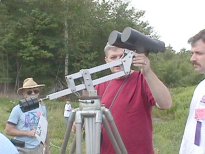 Parallelogram Binocular Mount Mike Heliba North Shrewsbury, VT First Place Special Award 1998 Stellafane Convention If you are reading this, chances are you are a new amateur astronomer. Welcome to an enjoyable and engaging hobby. However, you don't need a telescope to start out. In fact, conventional wisdom says that you should learn your way around the night sky with your unaided eyes or binoculars before you try to use a telescope. The reason for this is simple: Telescopes show you a tiny portion of the sky, and it takes some practice and large scale knowledge of the sky to effectively locate objects. Binoculars are easier to aim and use, because they show about 6 times more sky then a telescope - a bigger view in which it is easier to orient yourself. You can easily see the four Galilean moons of Jupiter, craters on the Moon, and brighter galaxies and nebula with binoculars. Once you can navigate the night sky, a telescope will be much easier to learn to use. For more information about getting started in amateur astronomy, check your library or bookstore for an introductory text, or see Sky & Telescope - Stargazing Basics on the web. Objective Size is Important 12.5" f/4.9 Newtonian German Equatorial Mount Marc Pepin Plesisville, Quebec Third Place Craftsmanship 1998 Stellafane Convention Many uninformed people believe the most important thing a telescope does is to magnify, or make objects bigger. While telescopes do magnify objects, the key attribute of any telescope is its ability to collect the light of dim astronomical objects and combine it it make them visible to the human eye. The large optical element that collects the light, whether it be lens or mirror, is called the objective. In most amateur telescopes, the size of this objective determines the aperture through which dim light is collected, and is the key parameter for characterizing the capabilities of the telescope. Hence, we talk about 80mm refractors and 6 inch reflectors - notice that magnification is not mentioned but the size of the objective is. The amount of light collected is directly proportional to the area of the objective, hence an 8 inch telescope collects 4 times more light than one with a 4 inch objective. Be suspicious of any telescope that stresses magnification over objective size. Another key attribute of larger objectives is better resolving power. Bigger objectives can resolve finer detail. i.e. show more swirls in Jupiter's atmosphere or more clearly show double stars as two separate points of light. However, turbulence in the atmosphere can and does defeat the resolving power of larger telescope, so while a larger objective will always collect more light, it might not show more detail except during periods of good seeing. Types of TelescopesThere are dozens of types of telescopes, however they can all be classified into one of three categories:
However, the secondary does block part of the aperture, resulting in some loss of light and due to diffraction effects, some loss of contrast due to scattering of light. Most designs try to minimize the secondary size.
The Gregory Maksutov-Cassegrain shown at right uses an aluminized spot on the Maksutov corrector lens as a secondary mirror. Not shown is a light baffle tube attached to the primary mirror hole. A focus that passes through the primary mirror is called a Cassegrain focus. Each type of telescope, and specific design, offers advantages and disadvantages - there is no one ideal telescope for all uses. Most all telescopes have interchangeable eyepieces. Different eyepieces have different focal lengths and apparent fields of view; when combined with a telescope they result in different magnifications and true fields of view. Types of Mounts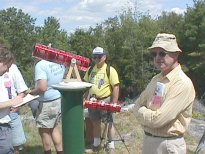 4" f/4 Coffee Can Newtonian Alt-Az Mount John Avellone, Alexandria, VA 1998 Stellafane Convention Could be Hand Held Although a few very low power, wide field telescope can be hand held, most telescopes need to
be held steady by a mount. A mount can easily cost more than the telescope it holds - when viewing at high magnification,
a mount must be very steady or the view will be a useless blur. At the same time, the mount must allow the telescope
to be aimed at all parts of the sky. Additionally, because the earth rotates, the position of objects in the
sky are constantly changing. Although barely perceptible to the unaided eye, at magnifications provided by telescopes
the objects in the sky will move out of the field of view in minutes or seconds. A tracking mount (often
called a mount with a clock drive) moves the telescope to counteract the earth's rotation and keep objects
in the field of view. Clock drives are certainly nice, but not a requirement for the successful mounting and
use of a telescope. However, they are required for all but the simplest astrophotography. 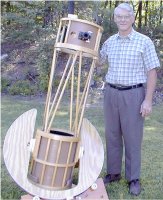 12" f/5 Newtonian Split-Ring Equatorial Dick Parker, Tolland, CT 1st Place Optical <12" 1998 Stellafane Convention Equatorial Mounts are designed with one axis of rotation aligned with that of the earth; tracking an object requires only rotation about this polar axis. Another axis, called the declination axis, is perpendicular to the polar axis. Combined, the two axis's of rotation allow the telescope to be aimed at the whole sky. Equatorial mounts come in many types: German equatorial mounts are popular choices for refractors and small reflectors (they do well with long tubes); fork mounts handle the short tubes of catadioptric scopes very well. There are a wide variety of other types too numerous to detail here. In order to track, the mount must be polar aligned, meaning the polar axis of the mount must be set parallel to the polar axis of the earth). Some beginners find aiming a telescope on an equatorial mount difficult, because the scope rotates on axis have unfamiliar orientations. 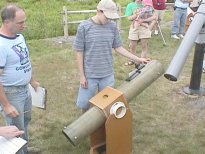 6" f/7 Newtonian Dobsonian Mount Ben Brunkner, Cambridge, MA Third Place Junior 1998 Stellafane Convention Altitude-Azimuth Mounts or Alt-Az Mounts, have an azimuth axis that rotates perpendicular to the ground, and an altitude axis that parallel to the ground. This motion is easy for humans to understand, and it is easier to build a steady, solid mount. The disadvantage is that tracking requires motion in two axis. John Dobson of the San Francisco Sidewalk Astronomers popularized a simple to build, smooth to operate, wooden Alt-Az mount that has been after him: The Dobsonian Mount. When combined with a Newtonian reflector, the whole thing is usually called a Dobsonian Telescope, or just simply Dobsonian. The simplicity of construction and operation combined with excellent stability and low cost has made this mount enormously popular with amateurs. Tracking can be added to Alt-Az mounts by (1) using a two axis drive under micro-controller or computer control; or (2) placing the entire Alt-Az mount on a tracking Equatorial Platform, such as a Poncet Platform or d'Autume Platform. Both computer drives and equatorial platforms have been built in several variations by many amateurs. Portability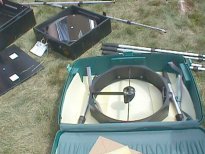 16" f/5 Suitcase Dobsonian Jack Gelfand Princeton, NJ Second Place Mechanical 1998 Stellafane Convention Portability is a key consideration that is overlooked by many beginners, who opt for the largest instrument they can afford. Unless you have a permanent observatory, you will have to move your telescope from it's storage location to your observing location. This may be as simple as moving from a garage or shed into the yard, or as complicated as driving to a remote site. As light pollution continues to brighten our night skies, more and more people need to drive to a dark sky site to have a reasonable observing environment (The Springfield Telescope Makers are proud to be members of the International Dark-Sky Organization). Remember, observing is done at night, and at the end of the observing session you are probably tired and ready for bed. A large, hard to handle scope can be a real annoyance at these times. A smaller scope that is easier to transport and set up may get used more, and give you more pleasure, then a larger, less convenient scope, and actually get used more often. Make or Buy?In the early days of amateur astronomy, unless you were very well off, you had no choice but to make your own telescope - they were custom ordered items built by a few skilled craftsmen. Today, there is a thriving commercial market serving amateur astronomers, and there are many telescopes offered at a variety of prices. Most amateurs today buy commercial telescopes and are quite successful using them. So why should one build a telescope? 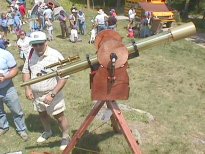 4" Brass Refractor Wooden Alt-Az Mount Joe Castoro Coram, NY Second Place Craftsmanship 1998 Stellafane Convention Cost: If you are on a very tight budget, and you are a scrounger, you can probably save a little money by building yourself a small telescope appropriate for a beginner. If you build a bigger telescope, something 14 inches or larger, you will save significant money by making your own mirror and building your own telescope. But for the beginner, cost is no longer a compelling reason to build. Quality: Mass production and the electronics revolution have led to expectations that commercial goods will continue to increase in quality and decrease in cost. Unfortunately, in optical fabrication the quality of the product is directly related to the amount of labor used. Good optics cost a lot of money because they have a lot of labor content. You can learn to make high quality optics, and you can choose to spend the time to get excellent or exceptional results. Spending a few extra hours figuring a mirror doesn't mean you will price your product out of the market. This is not say there are not many fine commercial telescopes offered for sale, but you do need to understand in optics, quality and cost are closely related. 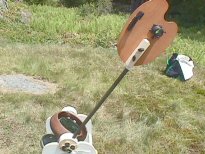 6" Salad-Bowl Newtonian Dobsonian Mount Emily Orzech Greensboro, NC Second Place Junior 1998 Stellafane Convention Knowledge: Many people enjoy knowing how thing work and how things are made. Telescope making brings together the fields of optics, mechanical engineering, metal and/or wood working, and often electronics and computers in fascinating way. While amateur astronomy may open your mind to the wonders and workings of the universe, telescope making will teach you skills and knowledge that are both interesting and practical. Pride: Many people take special pride in building things themselves. Telescope makers often fall into this category. Many amateur instruments are also showpieces, with beautiful wood tubes or finely polished metal parts. Many more are practical but homely, and their owners take just as much pride in having made a highly functional, if not beautiful, instrument. Most telescope makers are proud of their work, and they derive special satisfaction from using an instrument they have made themselves. As the Springfield Telescope Makers, our major interest is in making telescopes ourselves, and helping other people be successful in making telescopes. We think most people can be successful at making a telescope, and we encourage you to try. We hope these web pages will show you telescope and mirror making is not that hard, and the rewards and satisfaction are tremendous. That said, if you are more interested in observing than building; if you are not comfortable or feel you do not have the skills to do simple wood construction, you may be better off purchasing a telescope. Many people are reluctant to attempt to make a mirror, but are comfortable constructing the tube and mount. Telescope mirrors are available from many sources, and purchasing a mirror to use in a home-made tube is certainly an option that many telescope makers take these days. You can choose to make or buy essentially every component of your telescope. Many telescope makers are never finished with their scope - they are always upgrading or improving one component or another, making or buying the latest gadget, and above all having fun resulting in a very personal creation: Their very own telescope. Do what will be fun and enjoyable for you! Why Newtonian Reflectors on Dobsonian Mounts are good First Scopes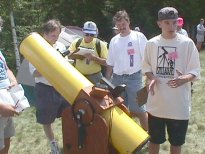 8" f/6 Newtonian Dobsonian Mount Robert Teeter Howell, NJ First Place Junior 1998 Stellafane Convention If you plan to make you own optics, mirrors are much easier to begin with than lenses. Glass for lenses is much more expensive than mirror blanks, and each lens needs two surfaces finished compared to one for a mirror. Wedge occurs in a lens when one surface is tipped with respect to another - and it takes some skill to prevent wedge. All told, you are advised to learn to make mirrors before you attempt to make lenses. Therefore, refractors and and catadioptrics are eliminated form the choices for beginning telescope makers. If your are buying or making your own telescope, Newtonian reflectors offer the most aperture for money, have a simple mechanical design, a simple, two component optical path and optical alignment (collimation) is straightforward and procedures are well documented. These are the many reasons the 6 to 8 inch Newtonian has been then telescope of choice for beginners for many generations. With the advent of the Dobsonian mount, an affordable, stable and smoothly operating mount is now available for the classic Newtonian, replacing the (somewhat clunky) pipe mounts of generation past. As a telescope maker, the Dobsonian mount can be constructed from plywood with simple hand tools. Make or buy, the "Dob" has all the right characteristics to make it a first choice. Selecting Mirror Size and Focal Length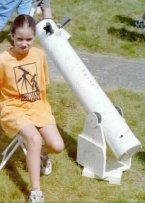 6" f/8 Newtonian Dobsonian Mount Elizabeth Ward Ridgefield, CT Honorable Mention Jr. 1998 Stellafane Convention The conventional wisdom is that a 6" f/8 or 8" f/6 is an ideal first mirror project and telescope choice. We agree. These both have 48" focal lengths, which result in manageable, fairly portable telescopes that are easy to build and use, and can be used to see both planets, their many of their moons, and hundreds of "deep sky" objects (single and multiple stars, star clusters, galaxies, and nebulae). Some people have chosen 10" or 12" mirrors as their first projects. Many have had success, but there is a tendency to want to keep the focal length short, and going below f/6 for a first mirror raises the difficulty considerably: There is much more glass to grind away, the slope of the parabola is much steeper, and figuring is much harder. You need to understand it's not the mirror diameter that makes these large mirrors more difficult, is the lower focal ratio. If you are buying optics, be aware that "fast" mirrors (low focal ratios) are harder to produce to high quality for all the reasons stated above, and are usually more costly. Telescope Formulas and Design ComparatorThis page has formulas for many telescope and mirror parameters. You can just look up a formula, or input a few numbers and it will calculate many parameters for two different telescope designs and compare the results for you. Spend some time with this page to understand the many tradeoffs involved in selecting a telescope. |
||||
|
Back to the ATM Index Page or Dobsonian Index Page |
||||


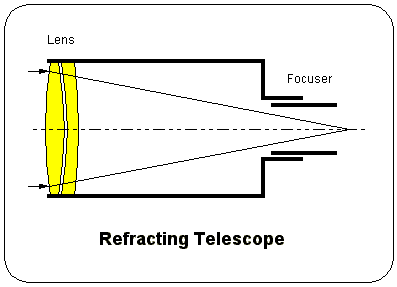 Refractors use only lenses to focus light, and are so named because the the bending of light by a transparent
medium such as a lens is called refraction. The first telescopes were refractors, as is the sea captain's
classical brass spyglass; the light passes through a tube entering at one end and coming to focus at the other.
Pictured is a achromatic refractor with a doublet lens, used to control chromatic aberrations that are present
with all lens based optical systems.
Refractors use only lenses to focus light, and are so named because the the bending of light by a transparent
medium such as a lens is called refraction. The first telescopes were refractors, as is the sea captain's
classical brass spyglass; the light passes through a tube entering at one end and coming to focus at the other.
Pictured is a achromatic refractor with a doublet lens, used to control chromatic aberrations that are present
with all lens based optical systems. 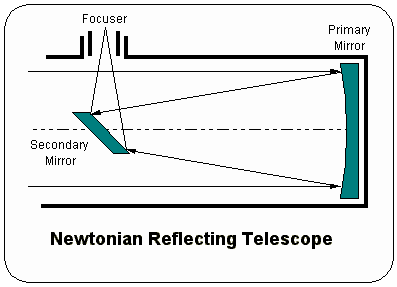 Reflectors use only mirrors to focus light. The Newtonian reflector, named after it's inventor Sir Isaac
Newton, is the classical amateur instrument and the type we describe how to build on these pages. Consisting
of a parabolic primary mirror and a flat secondary diagonal mirror, it simple and efficient.
Reflectors use only mirrors to focus light. The Newtonian reflector, named after it's inventor Sir Isaac
Newton, is the classical amateur instrument and the type we describe how to build on these pages. Consisting
of a parabolic primary mirror and a flat secondary diagonal mirror, it simple and efficient. 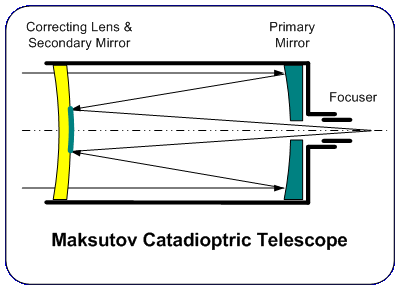 Catadioptric telescopes use a combination of lens and mirrors to focus light. Compact catadioptric designs,
such as the Schmidt - Cassegrain or Maksutov telescope, have become popular with amateurs in the last 30 years.
Catadioptric telescopes use a combination of lens and mirrors to focus light. Compact catadioptric designs,
such as the Schmidt - Cassegrain or Maksutov telescope, have become popular with amateurs in the last 30 years.